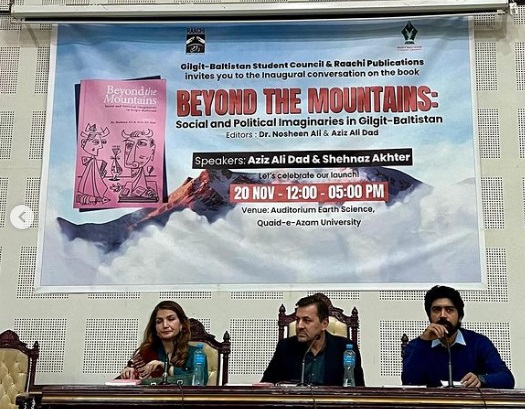Written by: Muhammad Asif Nawaz
Posted on: January 23, 2025 |  | 中文
| 中文
The editors, Aziz Ali Dad and Nosheen Ali, with other writers, including Zameer Abbas, Ashfaq Ahmed, Aafiyat Nazar, Iram Khan and Hafeez Shakir.
Beyond the Mountains: Social and Political Imaginaries in Gilgit Baltistan, published by Raachi Publications, is a groundbreaking collection of essays and articles that delve into the complexities of Gilgit Baltistan. The book's title, inspired by the feminine deity and goddess spirit of the land in Shina/Burushaski speaking Gilgit Baltistan, sets the tone for a nuanced exploration of the region's cultural, political, social and historical realities. Edited by Dr. Nosheen Ali and Aziz Ali Dad, this non-fiction book, divided into four parts, comprises sixteen articles and essays, catering to different facets of the reality of Gilgit Baltistan. They tell you never to judge a book by its cover, but even if you take the exception in this case, it will be fine. The cover stands out, only serving as an apt preamble to the content inside.
Living in Gilgit Baltistan for more than a year now, I have often found discourse on the area to be scanty or particularly skewed. Given Gilgit Baltistan’s huge, layered diversity (a few places, arguably, can stand out in the region), but it is somehow unnerving to see the lack of voices emanating from the region. In national consciousness, Gilgit Baltistan is rarely more than a tourist destination, with a conference of the world’s highest peaks, and a stereotypical comment on the people (which, even if positive, does not even begin to cover the various people in the region). There is a diversity of languages in the region, sects and classes co-exist with each other in an intricate design, and the local and the personal histories are often open to interpretation. In fact, so immense is the strength of the place in various regions of Gilgit Baltistan that I based my second novel in the region itself. In this scenario, to get a grasp of a book like Beyond the Mountains is refreshing and educational.

One of the editors, Aziz Ali Dad (center) during the inaugural conversation on the book at Quaid-i-Azam University (QAU), Islamabad.
The book educates, certainly (did you know that glaciers have genders?) and also inquires (what exactly is the “identity” of Gilgit Baltistan?), but foremost, it informs. Without having the urgent need to impress upon its own importance, without a semblance of exhibitionism cashing on Gilgit Baltistan; the book sheds light on various dimensions of life in Gilgit Baltistan. The book is dedicated to the guardian spirits that protect the land and soul of people in Gilgit Baltistan, and such fantastic ideals, add to the charm of the book, while also slightly taking away its core objectivity.
Dr Sitara Parveen, in Glaciers: Local Perceptions, Interpretations and Narrations, discusses glaciers in a new light, so that they cease to exist only as a natural phenomenon, but acquire an elevated position. In Symbiosis of Symbolic, Aziz Ali Dad beautifully puts to paper the indigenous beliefs of the region, and links the symbolic with the most pressing practical realities. The Dards, Dardistan and its Linguistic Diversity by Zubair Torwali is a very educational piece on the multitude of languages in the region. In A People’s History of Gilgit Baltistan, Zameer Abbass, after the initial introduction, traces the reality of the people smoothly through the poetry of Jan Ali. Evolution of Education in Hunza by Aafiyat Nazar lays bare the rocky start of education in a region that is now well-known for its literacy. Terra Nullis, Land Rights and Political Mobilisation in Gilgit Baltistan by Dr Nosheen Ali is among the hard-hitting pieces in the collection, leading to a few burning questions about the sociopolitical reality of the people. Israruddin Israr, in his short piece titled Politics, Society and Human Rights in Gilgit-Baltistan talks briefly about the past and present of political and social associations in the region. Iram Khan and Haider Ali, in Women of Gilgit Baltistan transforming society through Protest, bring their point across by commenting on three protests (#MeToo in Karakoram University, Justice for Adiba Movement and Hunza Sit-In). Gendered Fields: A Woman Ethnographer Studying Home by Dr. Humera Dinar is a very insightful, heart-felt piece about a local woman studying her own reality and position. In the essays, Between Celebration and Stigmatization: The Musicians of Yasin Valley and Bericho Community of Hunza and their Oral History of Exclusion, Basharat Isa and Shahnaz Akhter, respectively, delve into the details about two marginalised communities in the districts of Ghizer and Hunza. Besides these, the book also contains certain pieces in Urdu language. The Shina Cosmology by Mazhar Ali is a very interesting piece on the titular reality of the place, Gilgit Baltistan, the Region in Colonial Limbo has the writer Ashfaq Ahmed ask some serious questions about the future of the place. And then there are two poems, “Who worshipped the Nation” by Hafeez Shakir and the “Vanity Fair of Sufferings” by Anayat Baig. The last one is in Shina as well.
All in all, this volume provides some great insight into the complexities of the cultural and social richness and divergence of the region of Gilgit Baltistan. While some readers may find the academic tone and specific jargon challenging, the book's importance and enlightening content make it a valuable read. One minor criticism is that some pieces tend to present a binary, perhaps populist view of the situation, without acknowledging the other side.
Beyond the Mountains is a seminal work that sheds light on the rich cultural and social heritage of Gilgit Baltistan. Raachi Publications has done an excellent job in bringing together this collection of essays, and one hopes they will continue to publish such important works.
You may also like: